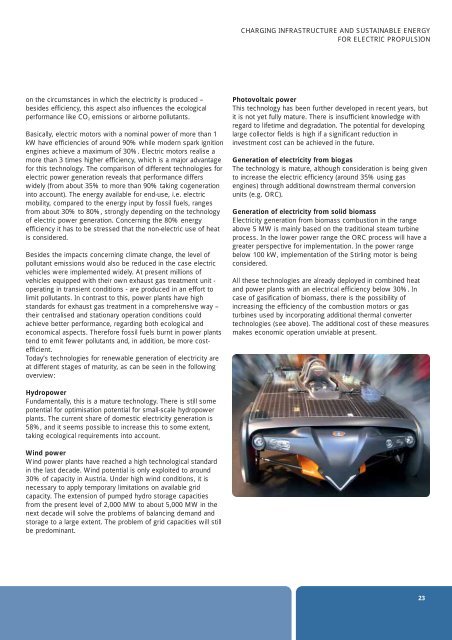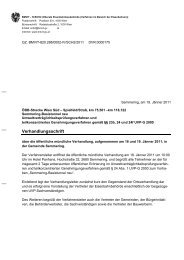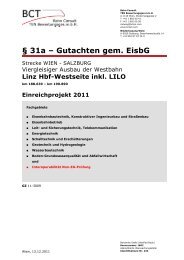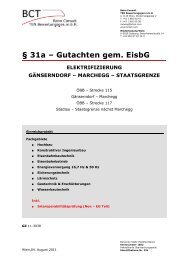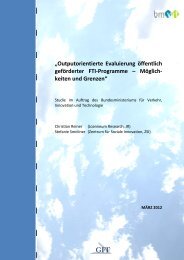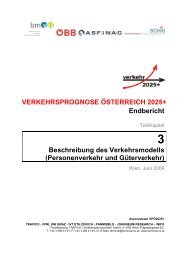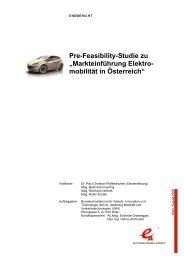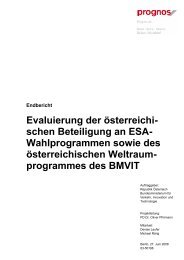Schriftenreihe .;technologiekompetenz Verkehr in
Schriftenreihe .;technologiekompetenz Verkehr in
Schriftenreihe .;technologiekompetenz Verkehr in
You also want an ePaper? Increase the reach of your titles
YUMPU automatically turns print PDFs into web optimized ePapers that Google loves.
on the circumstances <strong>in</strong> which the electricity is produced –<br />
besides efficiency, this aspect also <strong>in</strong>fluences the ecological<br />
performance like CO 2 emissions or airborne pollutants.<br />
Basically, electric motors with a nom<strong>in</strong>al power of more than 1<br />
kW have efficiencies of around 90% while modern spark ignition<br />
eng<strong>in</strong>es achieve a maximum of 30%. Electric motors realise a<br />
more than 3 times higher efficiency, which is a major advantage<br />
for this technology. The comparison of different technologies for<br />
electric power generation reveals that performance differs<br />
widely (from about 35% to more than 90% tak<strong>in</strong>g cogeneration<br />
<strong>in</strong>to account). The energy available for end-use, i.e. electric<br />
mobility, compared to the energy <strong>in</strong>put by fossil fuels, ranges<br />
from about 30% to 80%, strongly depend<strong>in</strong>g on the technology<br />
of electric power generation. Concern<strong>in</strong>g the 80% energy<br />
efficiency it has to be stressed that the non-electric use of heat<br />
is considered.<br />
Besides the impacts concern<strong>in</strong>g climate change, the level of<br />
pollutant emissions would also be reduced <strong>in</strong> the case electric<br />
vehicles were implemented widely. At present millions of<br />
vehicles equipped with their own exhaust gas treatment unit -<br />
operat<strong>in</strong>g <strong>in</strong> transient conditions - are produced <strong>in</strong> an effort to<br />
limit pollutants. In contrast to this, power plants have high<br />
standards for exhaust gas treatment <strong>in</strong> a comprehensive way –<br />
their centralised and stationary operation conditions could<br />
achieve better performance, regard<strong>in</strong>g both ecological and<br />
economical aspects. Therefore fossil fuels burnt <strong>in</strong> power plants<br />
tend to emit fewer pollutants and, <strong>in</strong> addition, be more costefficient.<br />
Today’s technologies for renewable generation of electricity are<br />
at different stages of maturity, as can be seen <strong>in</strong> the follow<strong>in</strong>g<br />
overview:<br />
Hydropower<br />
Fundamentally, this is a mature technology. There is still some<br />
potential for optimisation potential for small-scale hydropower<br />
plants. The current share of domestic electricity generation is<br />
58%, and it seems possible to <strong>in</strong>crease this to some extent,<br />
tak<strong>in</strong>g ecological requirements <strong>in</strong>to account.<br />
W<strong>in</strong>d power<br />
W<strong>in</strong>d power plants have reached a high technological standard<br />
<strong>in</strong> the last decade. W<strong>in</strong>d potential is only exploited to around<br />
30% of capacity <strong>in</strong> Austria. Under high w<strong>in</strong>d conditions, it is<br />
necessary to apply temporary limitations on available grid<br />
capacity. The extension of pumped hydro storage capacities<br />
from the present level of 2,000 MW to about 5,000 MW <strong>in</strong> the<br />
next decade will solve the problems of balanc<strong>in</strong>g demand and<br />
storage to a large extent. The problem of grid capacities will still<br />
be predom<strong>in</strong>ant.<br />
CHARGING INFRASTRUCTURE AND SUSTAINABLE ENERGY<br />
FOR ELECTRIC PROPULSION<br />
Photovoltaic power<br />
This technology has been further developed <strong>in</strong> recent years, but<br />
it is not yet fully mature. There is <strong>in</strong>sufficient knowledge with<br />
regard to lifetime and degradation. The potential for develop<strong>in</strong>g<br />
large collector fields is high if a significant reduction <strong>in</strong><br />
<strong>in</strong>vestment cost can be achieved <strong>in</strong> the future.<br />
Generation of electricity from biogas<br />
The technology is mature, although consideration is be<strong>in</strong>g given<br />
to <strong>in</strong>crease the electric efficiency (around 35% us<strong>in</strong>g gas<br />
eng<strong>in</strong>es) through additional downstream thermal conversion<br />
units (e.g. ORC).<br />
Generation of electricity from solid biomass<br />
Electricity generation from biomass combustion <strong>in</strong> the range<br />
above 5 MW is ma<strong>in</strong>ly based on the traditional steam turb<strong>in</strong>e<br />
process. In the lower power range the ORC process will have a<br />
greater perspective for implementation. In the power range<br />
below 100 kW, implementation of the Stirl<strong>in</strong>g motor is be<strong>in</strong>g<br />
considered.<br />
All these technologies are already deployed <strong>in</strong> comb<strong>in</strong>ed heat<br />
and power plants with an electrical efficiency below 30%. In<br />
case of gasification of biomass, there is the possibility of<br />
<strong>in</strong>creas<strong>in</strong>g the efficiency of the combustion motors or gas<br />
turb<strong>in</strong>es used by <strong>in</strong>corporat<strong>in</strong>g additional thermal converter<br />
technologies (see above). The additional cost of these measures<br />
makes economic operation unviable at present.<br />
23


